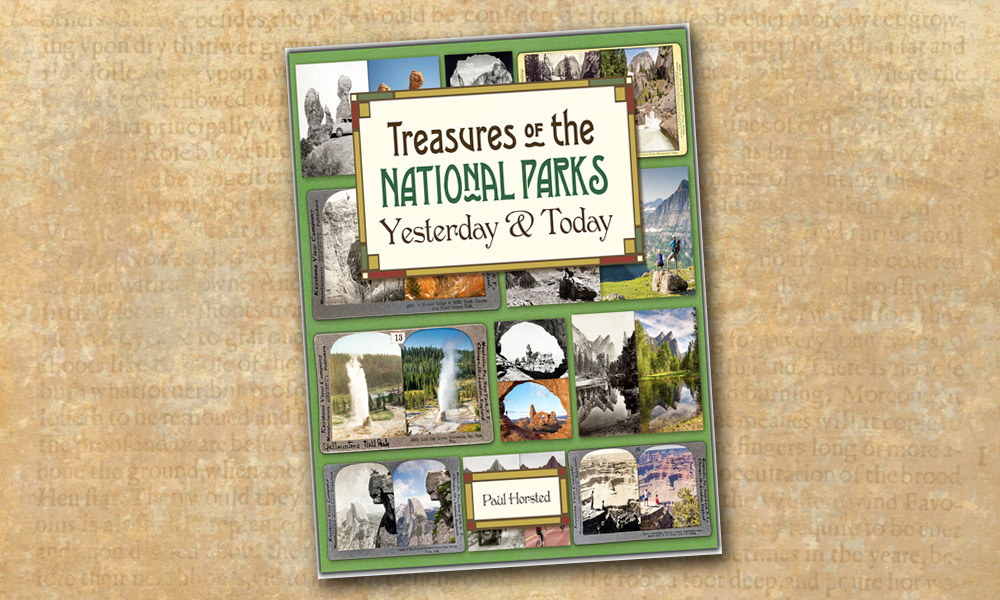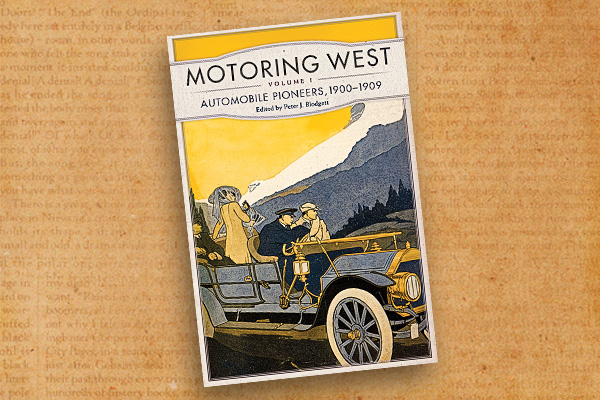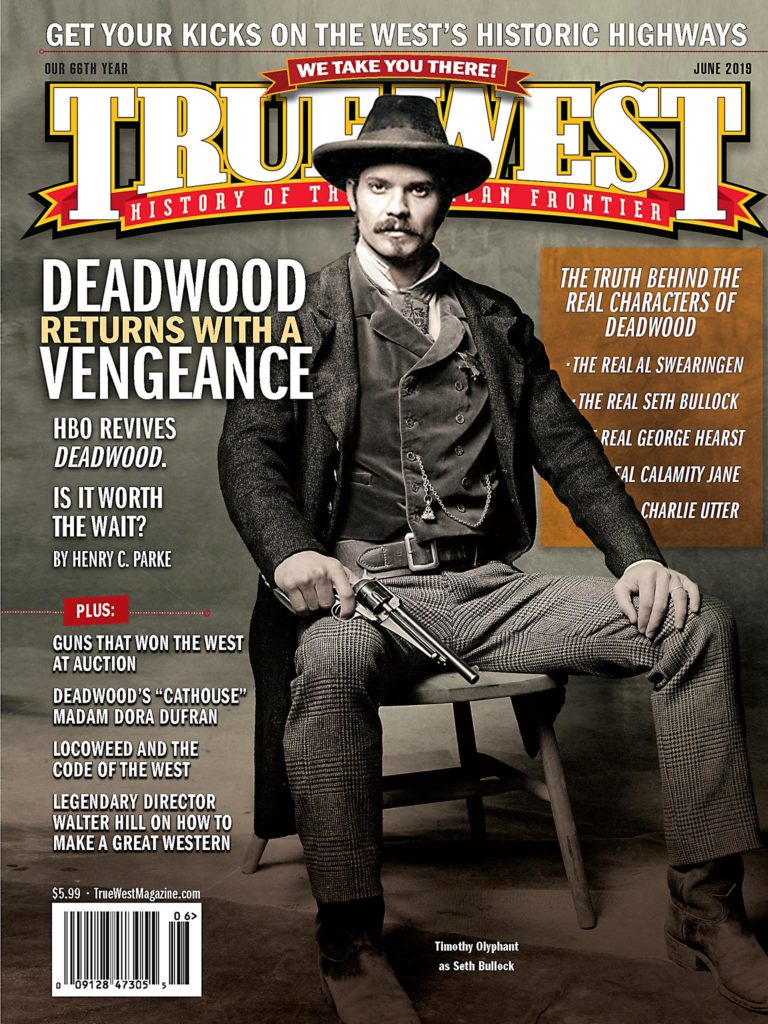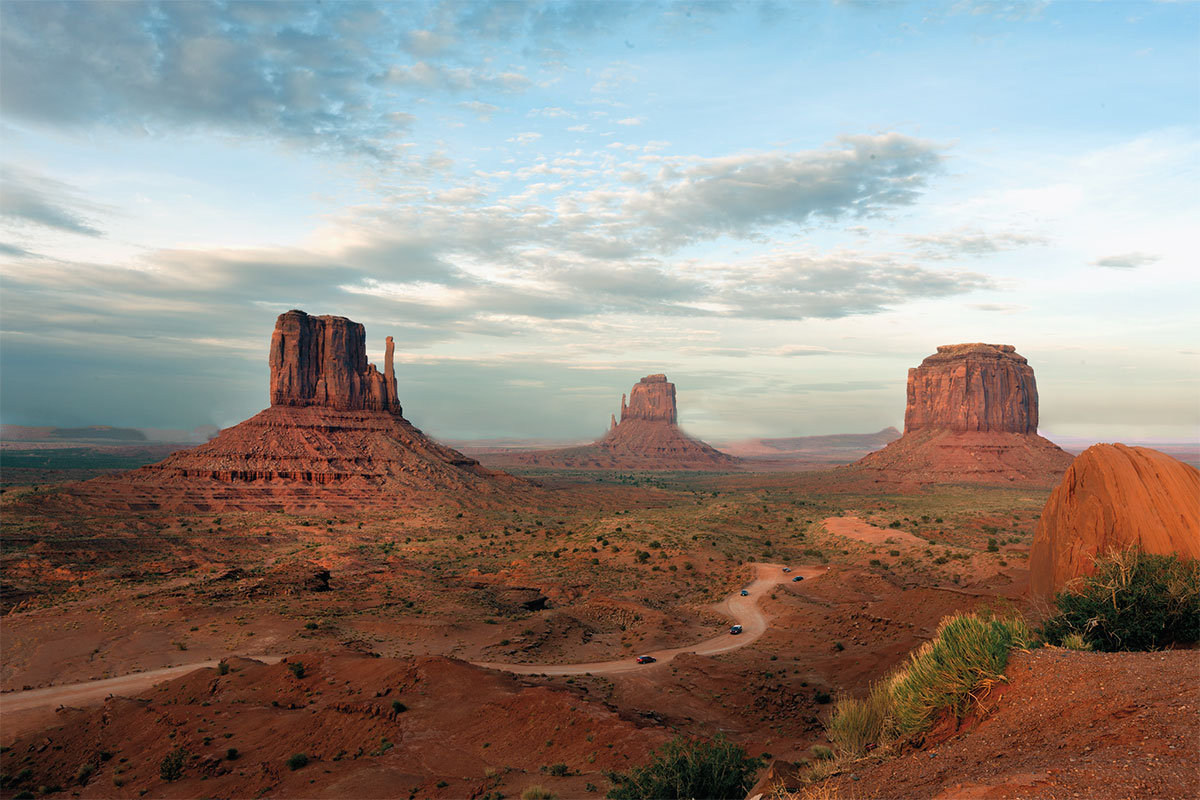
— Courtesy Carol M. Highsmith’s America, Library of Congress —
In 1927, the first Route 66 signs were posted from Chicago, Illinois, to Santa Monica, California, and the legend of the “Mother Road” began. The new U.S. Highway system was transforming the nation’s 19th-century emigrant, wagon and stage roads into a modern paved spider web of transcontinental roads that would eventually eclipse passenger rail service and elevate automobile tourism to the great 20th-century pastime.
With the snow melted off the high mountain passes, summertime has always been the perfect season for a Western road trip along these highways. From the Cascades of Oregon to the Southern Plains of Texas, from the Colorado Rockies to Nevada’s loneliest highway, adventurous travelers will discover the hospitality of big towns and small, historic inns and saloons, mom-and-pop diners and old Main Streets lined with local museums, one-of-a-kind stores and inviting, shady town squares. Side roads off the main highways lead to historic sites and parks, ghost towns, heritage hikes and photo opportunities of awe-inspiring Western landscapes.
True West’s editors have created ten heritage road trips that traverse the blue highways of 11 states. The tours are perfect for the summer but can be enjoyed during all four seasons (beware the high mountain passes!). The ten routes on scenic and historic byways and highways will lead to unforgettable experiences. So pack your bags and hit the road to re-discover the Old West one—highway, one town, one sunrise and one sunset at a time.
Four Corners
The Grand Circle Tour of Arizona, Utah, Colorado and New Mexico
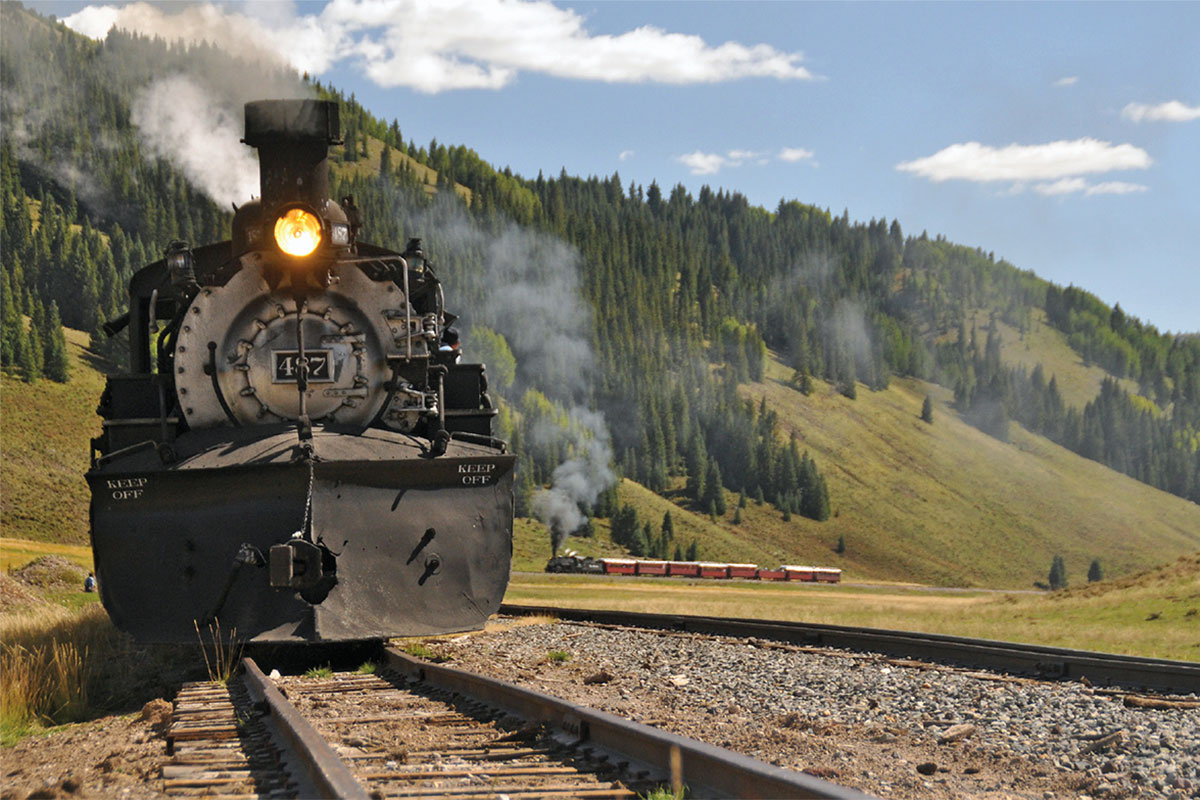
— Courtesy Durango CVB —
The Grand Circle Tour of the Four Corners is one of the classic road trips of the American Southwest. Ever since the Fred Harvey Company and the Santa Fe Railway began promoting the tour, visitors have been touring the region’s historic sites, Indian reservations, natural wonders and national and state parks. Start the tour in Flagstaff, Arizona, stay at the Monte Vista Hotel in historic downtown Flagstaff—just steps away from Route 66—and visit the Museum of Northern Arizona to gain a deeper understanding of the geologic and cultural history of the region. Schedule plenty of time in the Four Corners area to enjoy the tour to its fullest—and all the roadside stops and wonders along the way.
Mileage: 725 miles
Time: 5 to 7 days; if you have two weeks or a month, do it!
>>Bucket List
Cameron Trading Post, Cameron, AZ: This classic roadside stop includes a shop and a diner.
Goulding’s Lodge: Monument Valley, UT: Stay and eat where John Ford and John Wayne made their classic Westerns.
Monument Valley Tribal Park, AZ/UT:
The iconic park may be the most photographed and filmed site in the American West. The View Hotel has the best views of the park.
Durango-Silverton Narrow Gauge Railroad, Durango, CO: No matter your age or the season, don’t miss a ride on the historic railway round trip through Animas Canyon. Stay at the Strater Hotel, right next door to the depot.
Summer Nightly Indian Dances, Gallup, NM: Ceremonial cultural performances celebrate the Native culture of the Four Corners region. Free to the public, M-F, Memorial Day to Labor Day, 7-8 p.m., McKinley Courthouse Plaza.
La Posada Hotel, Winslow, AZ: One of architect Mary Jane Colter’s greatest Fred Harvey Hotels is fully restored, and an overnight there is a great way to end the tour.
>>Wide Spot in the Road
The Four Corners Monument, where you straddle all four states at once, is a great side trip when circling back to Arizona from Colorado on U.S. 160. After the obligatory photo-op, head south to Chinle, Arizona, and visit Canyon de Chelly National Monument.
Best Websites: VisitArizona.com; Travel.Utah.gov; Colorado.com; NewMexico.org; NPS.gov
Black Hills Scenic Loop
Cowboys, Miners and Hot Springs
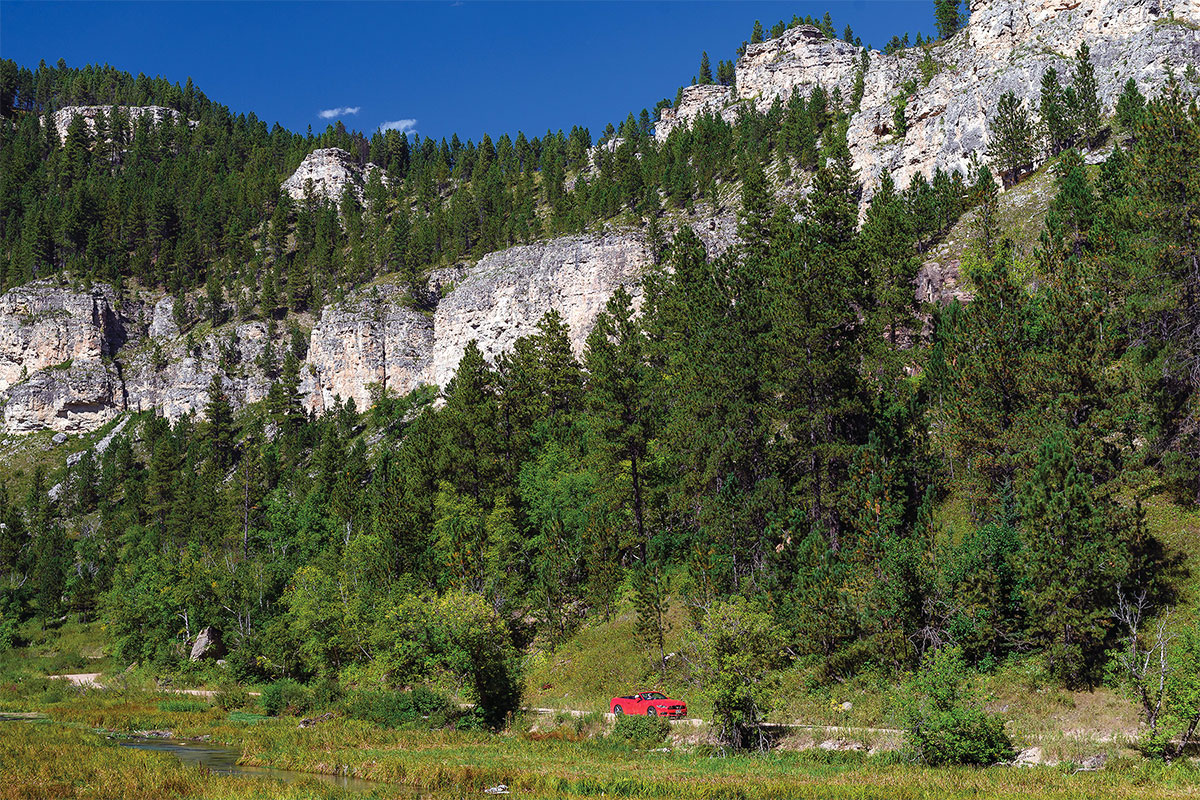
— Courtesy Chad Coppess, South Dakota Tourism —
The Black Hills offers a scenic drive with Western activities and historic sites around every curve. Start in Belle Fourche at the far northern end and schedule at least a week to tour the region from north to south, dividing the trip into two sections: the North Hills and the South Hills. Plan on walking the historic districts and visiting the museums of each of the Black Hills cities. Hiking, horseback riding, bicycling and fishing are enjoyed throughout the mountains.
Mileage: 235 miles
Time: 5 to 7 days; if you have two weeks, beat the heat and enjoy the mountain retreat.
>>Bucket List
Belle Fourche: The Tri-State Museum is the perfect place to start a tour of the Black Hills and to gain an overview of the people and culture of the region.
Spearfish Canyon Scenic Byway: After a tour of Spearfish’s High Plains Western Heritage Center, drive south on U.S. 14A, a scenic 21-mile drive that follows an old railroad grade. Enjoy a hike to Bridal Veil Falls and book a weekend in the Spearfish Canyon Lodge.
Deadwood: Book a room at the historic Bullock Hotel in walking distance of historic Main Street, the 1881 Courthouse Museum, Adams Museum & House and Days of ’76 Museum.
Custer State Park Wildlife Loop: This mini-Yellowstone experience is guaranteed to please all nature lovers. Book a room at one of the park’s historic lodges.
Crazy Horse Memorial: This inspiring monument honors one of America’s legendary Indian leaders.
Mt. Rushmore National Memorial: Mt. Rushmore inspires awe and reverence.
Hot Springs: After enjoying the world-famous Evans Plunge, tour the Mammoth Site of Hot Springs , an ancient sinkhole and archaeological excavation.
>>Wide Spot in the Road
Don’t miss an opportunity to hike to the top of the Mt. Roosevelt Memorial/Friendship Tower, just 2.5 miles from downtown Deadwood.
Best Websites: BlackHillsBadlands.com; TravelSouthDakota.com; Deadwood.com
West Texas Adventure
Amarillo to Big Bend National Park, Texas
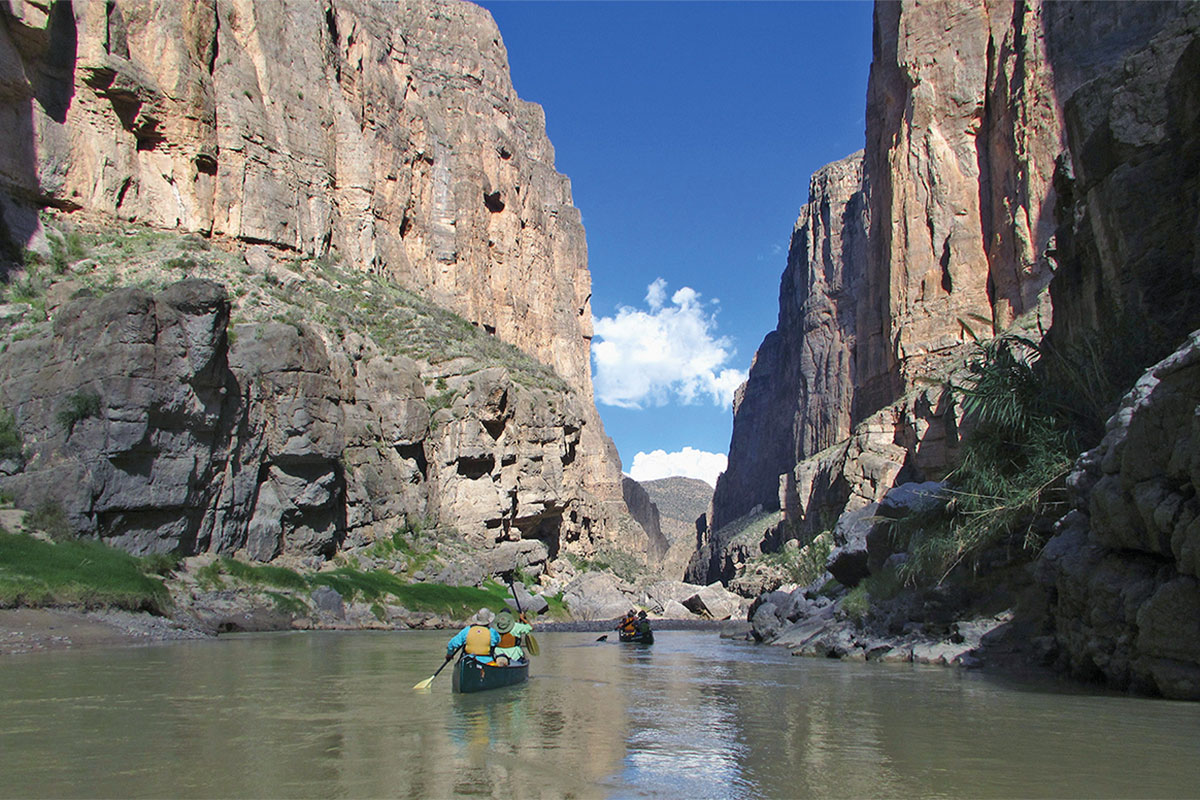
— Courtesy NPS.gov —
A West Texas adventure from Amarillo to Big Bend National Park is perfect for the road warrior who also loves the Old West. Don’t miss natural wonders like Palo Duro Canyon State Park on the way to the history museums and music scene of Lubbock, historic frontier forts in Fort Davis and Fort Stockton and quintessential West Texas towns of Pecos, Marfa and Alpine. And instead of a traditional straight-line tour, this southern plains trip zig-zags between state routes, U.S. highways and interstates north to south to its final destination, Big Bend National Park.
Mileage: 490 miles
Time: 5 to 7 days; the lure of the open road and West Texas hospitality might mean a longer stay.
>>Bucket List
Amarillo: Summertime is a great time to visit the Panhandle city, enjoy tours of Amarillo’s American Quarterhorse Heritage Center & Museum, Canyon’s Panhandle-Plains Historical Museum and attend TEXAS!, the musical drama performed at the Pioneer Amphitheatre in Palo Duro Canyon, Tuesdays to Sundays, June 1 to August 17, 2019.
Lubbock: The “Hub City” of West Texas, Lubbock is a town to relax in with great restaurants and local music. When not dining and dancing, soak up local history at its numerous museums, including the American Wind Power Center, Bayer Agricultural Museum, National Ranching Heritage Center and the Buddy Holly Museum.
Fort Stockton: The West Texas frontier town is a perfect place to spend a few days and explore its historic sites including Fort Stockton, Pecos County Courthouse, Historic Old Jail of 1884 and the Annie Riggs Memorial Museum.
Alpine: The gateway city to Big Bend National Park offers small-town hospitality, restaurants and shops to visit after a tour of the Museum of the Big Bend.
Big Bend National Park: One of America’s treasures, Big Bend National Park is a great place to escape from the daily routine. Book a room at the historic Chisos Mountains Lodge and explore the wonders of the isolated, rugged park.
>>Wide Spot in the Road
Fort Davis National Historic Site is the best-preserved frontier fort in the Lone Star State and offers living history events throughout the year.
Best Websites: VisitTexas.com; TPWD.Texas.gov; NPS.gov
High Desert to Mountain Lakes
Boise to Bonner’s Ferry, ID

— Courtesy Idaho Tourism —
The vistas and natural beauty along the winding highways
of western Idaho are stunning and awe-inspiring. Starting in the high desert valley of the state capital of Boise, the state and U.S. highways north to Bonner’s Ferry are an inter-connected route of some of Idaho’s most beloved byways. Along sections of the Payette River, Northwest Passage, White Pine, Lake Couer D’Alene, Wild Horse Trail and Pend Oreille Scenic Byways, the traveler will discover history and hospitality in Idaho’s small towns.
Mileage: 454 miles
Time: A week is the perfect amount of time to enjoy the wonders of western Idaho along U.S. 95.
>>Bucket List
Boise: Start a scenic trip to Idaho with a tour of some of the state’s best museums, including the state capitol, the Idaho State Museum, the Basque Museum and Cultural Center and the Museum of Mining and Geology.
Lewiston: After a jet boat trip up the Snake River into Hell’s Canyon, the deepest river gorge in North America, take time to tour the Lewis and Clark Discovery Center and the Nez Perce County Historical Society Museum.
Coeur d’Alene: Coeur d’Alene started as an Army outpost in 1880, but after a major silver strike in the area, it became a major center of mining. Book a room overlooking Coeur d’Alene Lake and learn about the area’s rich cultural history at the Museum of Idaho and Cataldo Mission State Park.
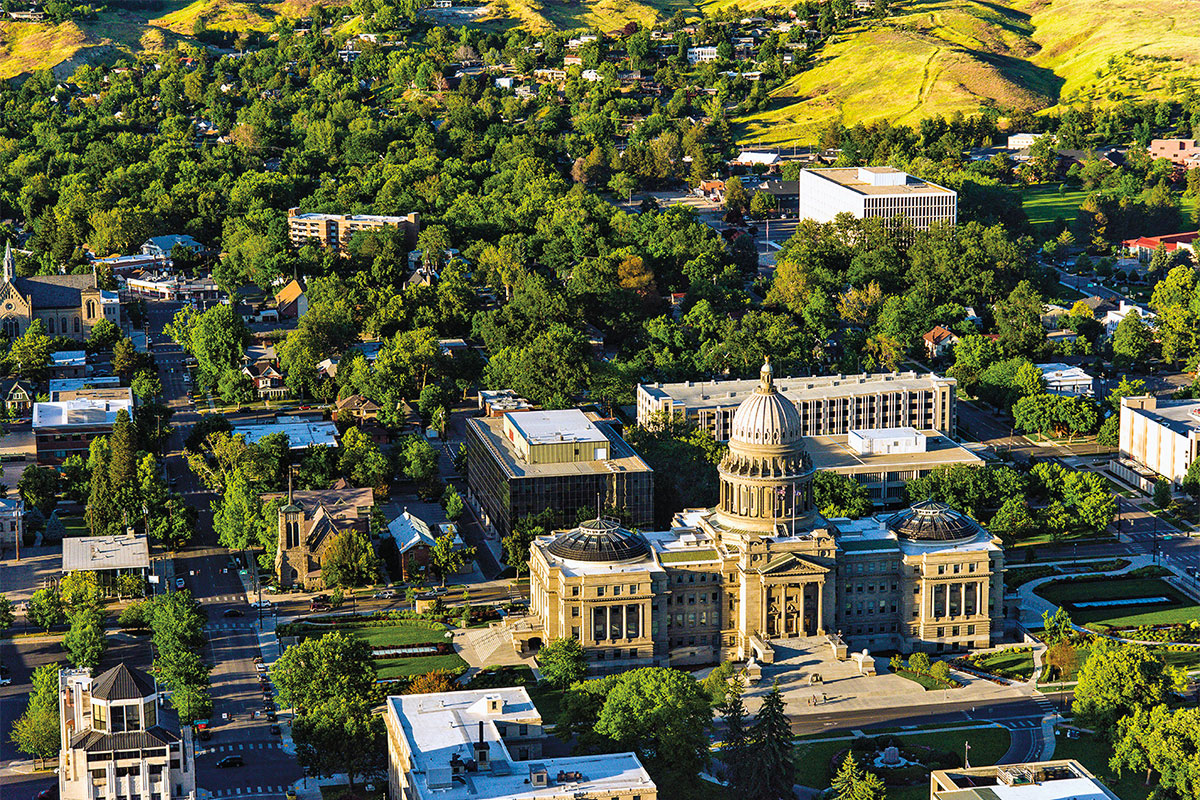
— Courtesy Idaho Tourism —
Sandpoint: British explorer David Thompson built a trading post here near Lake Pend Oreille in 1809. Don’t miss a tour of the Bonner County History Museum and a drive on the Pend Oreille Scenic Byway.
Bonner’s Ferry: Named for Edwin Bonner, who established a ferry across the Kootenai River on the Wildhorse Trail after gold was discovered in the remote boundary area in 1863, Bonner’s Ferry developed into vibrant mining, merchant, timber and farm community in the late 19th- and early 20th-century.
>>Wide Spot in the Road
Book a room at the historic Shore Lodge on picturesque Payette Lake in McCall, a beautiful place to rest and relax on the road trip. Don’t miss a tour of the Central Idaho Historical Museum to learn about the region’s Indian and fur trade history.
Best Websites: VisitIdaho.org; NPS.gov; FS.USDA.gov
Cactus to Pines
Wickenburg to Grand Canyon National Park, AZ
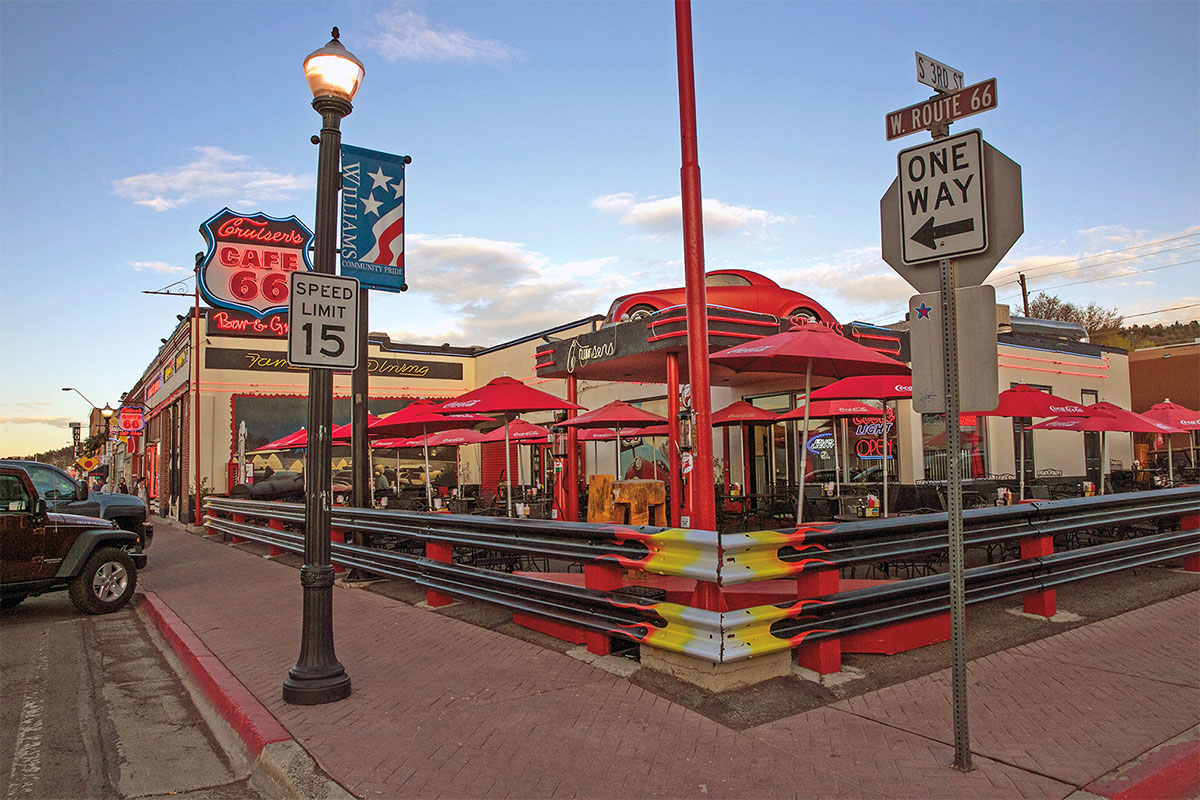
— Courtesy Williams CVB —
When the Walker Party discovered gold near Prescott in 1863, they followed a trail up the Hassayampa River from the Wickenburg area through the Bradshaw Mountains to Granite Creek. Flash forward to the 1920s and the new industry of auto tourism and the Hassayampa Trail moniker was given to Highway 89 from Wickenburg to Ash Fork—a cactus to pines tour that led tourists and locals out of the summer heat to the cooler climes of central and northern Arizona—including Williams and the Grand Canyon. Today, the scenic highway remains a link between Arizona’s historic communities of Wickenburg, Prescott, Chino Valley, Ash Fork, Williams and the Grand Canyon.
Mileage: 471 miles
Time: A week at minimum, but once you get to the Grand Canyon, you may want to stay all summer.
>>Bucket List
Wickenburg: Enjoy walking the historic downtown and visiting the Desert Caballeros Western Museum before booking a luxurious stay at a local guest ranch, such as the Flying E Ranch or Rancho de los Caballeros.
Prescott: The state’s original Territorial capital, the mile-high city has a lot to offer a lover of the Old West, including Sharlot Hall, the Phippen and the Smoki museums; the oldest bar in Arizona, The Palace Restaurant and Saloon; and the World’s Oldest Rodeo and Frontier Days Parade held every year over the Fourth of July.
Williams: Visitors to Williams will enjoy the nostalgic shops, galleries and restaurants along historic Route 66 before boarding the Grand Canyon Railway for a thrilling round-trip ride to Grand Canyon National Park.
Grand Canyon National Park: To celebrate the park’s centennial in 2019, splurge and book a room at El Tovar or Bright Angel Lodge, take a mule ride to Phantom Ranch, visit the Desert Watchtower and enjoy the peace and tranquility of watching the stars at night.
>> Wide Spot in the Road
Between Wickenburg and Prescott, the town of Yarnell on State Route 89 is a good place to get out and explore, have a meal at a local diner and visit the Granite 19 Hotshots Memorial, which was built to honor the 19 firefighters who gave their lives trying to save the town from the 2013 Yarnell Hill Fire.
Best Websites: VisitArizona.com; NPS.gov; FS.USDA.gov
Tracking the Union Pacific
Cheyenne to Evanston, WY
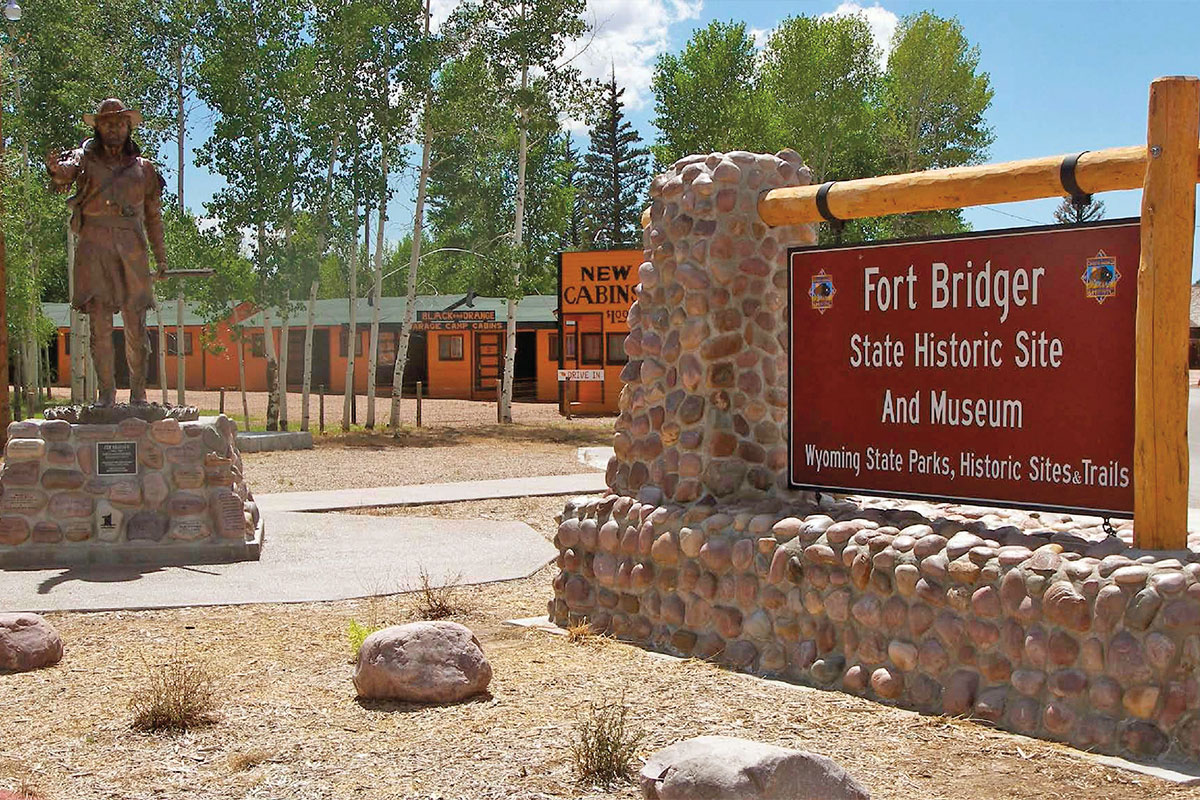
– Courtesy Wyoming Tourism –
The scenic drive from Cheyenne to Evanston, Wyoming, on Interstate 80 is a bucket-list trip for the railway enthusiast. In 1869, the Union Pacific began its national rail service and the original railbed parallels the modern U.S. 30 and I-80 route across the southern tier of the Cowboy State. The UPRR rail-route tour on Interstate 80 will introduce the heritage traveler to a chain of Wyoming cities founded during the railroad’s construction as well as cross the historic Oregon Trail at Fort Bridger State Historic Site, one of the oldest American settlements.
Mileage: 357 miles
Time: 5 to 7 days allows plenty of time for driving scenic highways and sightseeing off the interstate.
>>Bucket List
Cheyenne: Book a room at the recently reopened Plains Hotel in the downtown district and spend a weekend touring the city, including the Wyoming State Museum, Cheyenne Frontier Days Old West Museum, Cheyenne Depot Museum and the Nelson Museum of the West.
Laramie: Home of the University of Wyoming, Laramie, like Cheyenne, is a city of excellent Western museums. Stay at least two days and immerse yourself n history at the American Heritage Center, Laramie Plains Museum, Laramie Historic Railroad Depot and the Wyoming Territorial Prison State Historic Site.
Rawlins: Enjoy the drive through Medicine Bow National Forest on the way to Rawlins. Home to the Wyoming Frontier Prison Museum, the city was founded by the Union Pacific Railroad. Learn about the area’s rich history at the Carbon County Museum.
Rock Springs: Nearby deposits led to the town’s development to supply coal to the Union Pacific Railroad. After touring the Natural History Museum take a drive on the Pilot Butte Wild Horse Scenic Loop.
Evanston: Founded by the UPRR during the railroad’s construction in 1868, the city and the tri-state area history can be discovered at the Uinta County Museum, Roundhouse and Railyards and the Chinese Joss House Museum.
Wide Spot in the Road: Fort Bridger State Historic Site is located at the crossroads of the Oregon, California and Mormon overland trails. The living history museum annually hosts the Fort Bridger Mountain Man Rendezvous.
Best Websites: WyomingTourism.org; FS.USDA.gov
Border to Border
Klamath Falls to The Dalles, OR

— Courtesy NPS.gov —
A tour on one of Oregon’s oldest highways from Klamath Falls to The Dalles on U.S. highways 97/197 is a beautiful option over Interstate 5. Just north of the California state line on U.S. 97, historic Klamath Falls is the perfect place to start a border-to-border tour of the Beaver State, following state and U.S. highways north along the eastern slope of the Cascades to The Dalles and the Columbia Gorge. Along the way, the traveler will discover the wonders of the state’s dramatic mountains, forests plains, rivers, parks and historic sites.
Mileage: 266 miles
Time: 5 days, but if you have more vacation time saved up, schedule a couple of weeks to truly immerse yourself in the communities of the eastern Cascades.
>>Bucket List
Klamath Falls: Start your tour at the Klamath Falls Museum to discover the rich cultural history of the local Klamath and Modoc tribes and the role of the Applegate Trail in the town’s development. The Favell Museum houses one of the state’s finest Indian artifact and Western art collections.
Crater Lake National Park: One of the oldest national parks, Crater Lake is a place to stop and enjoy for a couple days. Book a room at the historic Crater Lake Lodge, take the Rim Drive and then enjoy the natural wonder’s great trails.
Bend: Located at a historic crossing of the Deschutes River on the eastern slope of the Cascades, the high desert city is known for its welcoming climate and livability. Don’t miss a tour of the High Desert Museum to learn about the region’s cultural heritage.
Sisters: After taking a side tour on the McKenzie Pass-Santium Pass Loop, recharge and relax at the Long Hollow Guest Ranch.
The Dalles: Where the Oregon Trail ended at the Columbia River before an overland trail was developed over the Cascades, is the crossroads city where visitors tour the Columbia Gorge Discover Center, Fort Dalles Museum and Anderson Homestead and the Dalles Lock and Dam Visitor Center.
>> Wide Spot in the Road
Madras, a historic farming and railroad town, has excellent restaurants for the weary traveler, and nearby, a jewel of a regional site, the Museum at Warm Springs, which celebrates the culture of local tribal history.
Best Websites: TravelOregon.com; NPS.gov; FS.USDA.gov
Get Lost in the Rockies
Glenwood Springs to Trinidad, CO

– Courtesy Colorado Tourism –
Getting lost in the Rocky Mountains of Colorado for the summer is an easy thing to do for the Western traveler who loves high mountain passes, four-wheel drive tracks to old mines and historic towns, villages and sites around every curve. But, since most of us don’t have all summer—and most of us don’t want to get lost—a winding, slow drive up, down, around and over the Rockies from Glenwood Springs to Trinidad will provide enough Old West experiences and awe-inspiring photo opportunities to warrant coming back for another summer of “getting lost” between the peaks and valleys of Colorado’s world-famous 14,000-foot peaks.
Mileage: 292 miles
Time: 5 days at the minimum, but if you enjoy four-wheeling and hiking, take 10 days to two weeks to really explore the mountains, valleys and historic towns.
>>Bucket List
Glenwood Springs: After touring Pioneer Cemetery, the final resting place of John Henry “Doc” Holliday and Kid Curry, enjoy a visit to the Frontier Museum, Glenwood Hot Springs Resort, Pool, Lodge and Spa (a perfect place to start the tour) and the Glenwood Vaudeville Revue dinner theater.
Crested Butte: A year-round destination Rocky Mountain getaway, Crested Butte is a great place to stay and explore the mountains on thrilling jeep trails to ghosts of the area’s mining past, including Schofield Pass.
Gunnison: Located on the scenic highway between Montrose and Salida, the high-mountain city is a gateway to Gunnison National Forest. After a tour of the Gunnison Pioneer Museum, if you have a four-wheel drive vehicle, don’t miss a chance to photograph the abandoned Crystal Mill.
Alamosa: Alamosa is home to the Rio Grande Scenic Railroad, which thrills passengers on its route over LaVeta Pass. Book a room at the historic Windsor Hotel and enjoy the hospitality of the city founded in 1878, and a side trip to the Great Sand Dunes National Park.
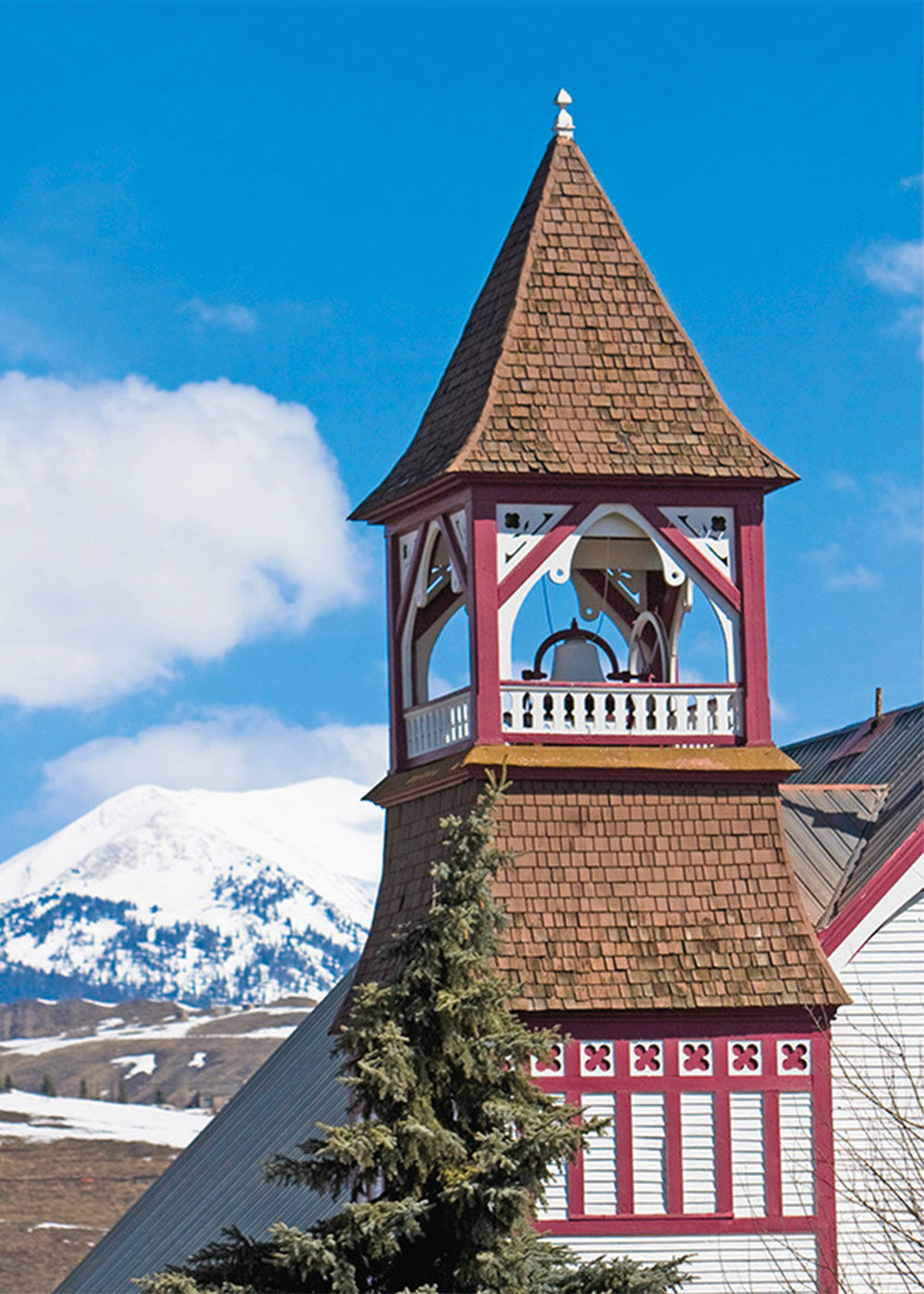
— Courtesy Colorado Tourism —
Trinidad: Located in Raton Pass, the historic Santa Fe Trail, railroad and coal mining city’s historic district deserves at least two days of exploration. Don’t miss the world-class A.R. Mitchell Museum of Western Art and the Trinidad History Museum.
>> Wide Spot in the Road
Fort Garland, “Gateway to the San Luis Valley,” was founded in 1858. Tour the Fort Garland Museum to discover the role of the Army in the settlement of the region.
Best Websites: Colorado.com; NPS.gov; FS.USDA.gov
Big Sky Loop
Montana from Billings to Bozeman and Back

— Courtesy NPS.gov —
For many, Montana is a state of mind and a scenic-loop adventure from Billings to Red Lodge through Yellowstone National Park to the historic southwestern region of the Big Sky State back to Billings via Bozeman and Livingston might just prove to be a life-altering event. Along the way, the traveler will discover the heritage and diversity of small-town Montana life, the wonders of Yellowstone’s northern tier (including its magnificent buffalo herd), historic Red Lodge and Virginia City, and the constant distraction of some of the most beautiful vistas and mountain ranges in North America.
Mileage: 551 miles
Time: Two weeks exploring Montana and Yellowstone on this scenic loop of natural wonders, historic sites and small towns will lead you back to the Big Sky every year.
>>Bucket List
Billings: One of the state’s larger cities, Billings is known for its art galleries and museums, including the Yellowstone Art Museum, Moss Mansion, Western Heritage Center and Yellowstone County Museum.
Red Lodge: Spend a day and night exploring and relaxing in this quintessential Montana town, a gateway city to Yellowstone National Park. The real Jeremiah “Liver Eatin’” Johnson was the town’s first constable.
Yellowstone National Park: From Red Lodge, enter the park on the spectacular Beartooth Highway and make reservations well in advance at the park’s Roosevelt Lodge and Cabins. Built in 1920, the lodge is near a campsite once used by President Theodore Roosevelt in the Tower Falls district of the nation’s first national park.

– Courtesy NPS.gov
Bozeman: Home to Montana State University, the city has a vibrant downtown of eclectic restaurants and brewpubs, lots of lodging and two excellent museums—the Museum of the Rockies and the Gallatin History Museum.
Livingston: Once an important hub for the Northern Pacific Railway and its shortline to Yellowstone National Park, the city’s historic district, including the Livingston Depot Center and Gateway to Yellowstone Museum, is worth scheduling extra time to visit.
>> Wide Spot in the Road
Virginia City, one of the best preserved mining boomtowns in the West, was once the Territorial capital of Montana. Step back in time and book a night in one of the seasonally operated hotels.
Best Websites: VisitMt.com; NPS.gov; StateParks.MT.gov; FS.USDA.gov
The Loneliest Highway
U.S. 50 from Carson City to Great Basin National Park, NV

— Courtesy TravelNevada —
Far from the bright lights of the Las Vegas strip, an old-fashioned road trip on U.S. 50, will provide the traveler an Old West experience extraordinaire. The weather and the distances can seem extreme depending on the season, but the old Pony Express/Central Overland Route from Carson City to Great Basin National Park is dotted with inviting and welcoming small towns filled with history and unique historic sites. Pack your bags, hiking shoes, maps and music and drop off the grid for a historic adventure along one of America’s first transcontinental roads. You will wonder why it took you so long to drive America’s loneliest highway.
Mileage: 386 miles
Time: 5 to 7 days allows time to really get lost in the historic towns and sites along Nevada’s stretch of U.S. 50.
>>Bucket List
Carson City: The historic capital city of Nevada is the perfect place to kick off a road trip across the Silver State. Don’t miss a tour of the Nevada State Museum in the old U.S. Mint building, the Nevada State Railroad Museum and the state capitol grounds.
Fort Churchill State Historic Park: One of the best preserved military “ghosts” on the route, the Army fort protected Pony Express riders and overland travelers between 1860 and 1869.
Eureka: Known as the “Friendliest Town on the Loneliest Road in America” the former mining boomtown’s 19th-century historic district is worth the stop. Make time to visit the Eureka Opera House, Raine’s Market and Wildlife Museum, the Jackson House Hotel and the Eureka Sentinel Museum.
Ely: A National Historic Landmark, the Nevada Northern Railway is one of the finest in the United States. Passengers can sign up for a special hands-on “Be the Engineer” program in which they drive the heritage train for two hours through Robinson Canyon toward the Old Ruth Mining district.

— Courtesy NPS.gov —
Great Basin National Park: Spend two to three days exploring the park, from sagebrush foothills to 13,063-foot Wheeler Peak. The park’s visitor center is in the nearby town of Baker.
>>Wide Spot in the Road
The single building town of Middlegate is a must stop on U.S. 50. Since the Pony Express days, a traveler’s rest stop has existed at Middlegate, which has a gas station, hotel, bar and restaurant. Take time to drive out to Berlin-Ichthyosaur State Park, a ghost town amidst a preserved dinosaur site.
Best Websites: TravelNevada.com; NPS.gov; FS.USDA.gov
Stuart Rosebrook’s favorite scenic highways always lead to a historic Western town where he can hang his hat for a few days and enjoy the local hospitality.

